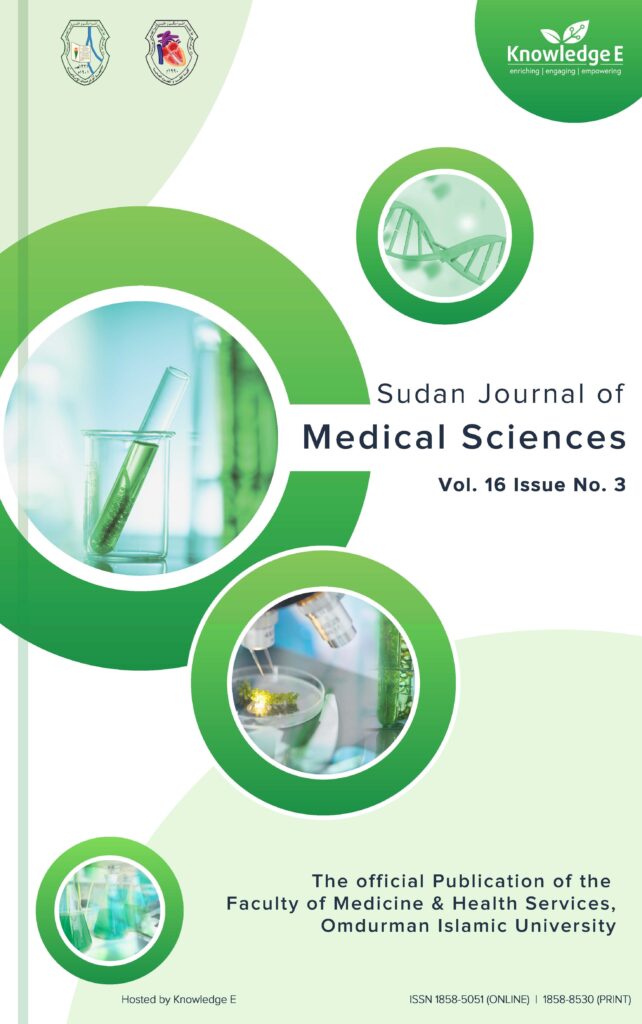
Sudan Journal of Medical Sciences
ISSN: 1858-5051
High-impact research on the latest developments in medicine and healthcare across MENA and Africa
Epilepsy Classification (ILAE Classification 2017) in Resource-limited Countries: A Cross-sectional Study on Epilepsy in Pediatric Patients from Sudan
Published date:Dec 29 2023
Journal Title: Sudan Journal of Medical Sciences
Issue title: Sudan JMS: Volume 18 (2023), Issue No. 4
Pages:488 - 497
Authors:
Abstract:
Background: The objective of this study is to utilize the ILAE 2017 to classify epilepsy patients and determine its applicability in Sudan.
Methods: This study is a prospective, descriptive, cross-sectional research conducted in two pediatric epilepsy clinics in Khartoum State, Sudan.
Results: In this cross-sectional study, 350 pediatric patients with epilepsy were included, with a mean age of 8.4 ± 4.7 years and a mean illness duration of 4.71 ± 3.91 years. The ILAE classification was applied, showing that 71.11% of patients had generalized onset seizures, 27.7% had focal onset seizures, and only 1.1% had unknown onset seizures. Among patients with focal onset seizures, 56.4% had intact awareness, while 43.6% had impaired levels of awareness. The majority of patients who had generalized onset seizures experienced motor onset seizures, with tonic-clonic seizures being the most common (44.2%). Nearly all patients with unknown onset seizures experienced tonic-clonic convulsions. These findings provide insights into the prevalence and types of seizures among pediatric epilepsy patients in Sudan and can guide clinicians in developing appropriate treatment plans.
Conclusion: This study highlights the importance of utilizing the latest ILAE classification 2017 in epilepsy classification and its potential utilization in resource-limited areas like Sudan.
Keywords: epilepsy, classification, ILAE, Sudanese, children
References:
[1] Fisher, R., Acevedo, C., Arzimanoglou, A., Bogacz, A., Helen Cross, J., Elger, C. E., Engel, Jr, J., Forsgren, L., French, J. A., Glynn, M., Hesdorffer, D. C., Lee, B. I., Mathern, G. W., Moshe, S. L., Perucca, E., Scheffer, I. E., Tomson, T., Watanabe, M., & Wiebe, S. (2014). ILAE official report: A practical definition of epilepsy. Epilepsia, 55(4, 457–482. https://doi.org/10.1111/epi.12550
[2] Abass, B., Mohamed, I., Elseed, M., & Karra, Z. (2014). Causes of uncontrolled Seizures among Sudanese children. Khartoum Medical Journal, 7(1), 915–920.
[3] Ogunrin, O. A., Adeyemi, J. D., & Ogunrin, A. O. (2018). Epilepsy in Nigeria: A review of etiology, epidemiology, and management. Journal of Neurology Research, 8(3), 51–57. https://doi.org/10.14740/jnr454w
[4] International League Against Epilepsy. (2017). Epilepsy diagnosis. https://www.ilae.org/visitors/centre/diagnosis.cfm
[5] World Health Organization. (2019). Epilepsy. https://www.who.int/news-room/factsheets/ detail/epilepsy
[6] Kaddumukasa, M., Kaddumukasa, M. N., Buwembo, W., Munabi, I. G., Blixen, C., Lhatoo, S. (2018). Comparison of the International Classification of Diseases 10th Edition (ICD-10) and the International League Against Epilepsy (ILAE) 2017 classifications in a low-income country setting. Epilepsy & Behavior, 85, 41–46.
[7] Fisher, R. S., Cross, J. H., French, J. A., Higurashi, N., Hirsch, E., Jansen, F. E., Lagae, L., Moshé, S. L., Peltola, J., Roulet Perez, E., Scheffer, I. E., & Zuberi, S. M. (2017). Operational classification of seizure types by the International League Against Epilepsy: Position Paper of the ILAE Commission for Classification and Terminology. Epilepsia, 58(4), 522–530.
[8] Ahmed, A., Elhassan, M., Elhassan, H., Salih, M., Ali, E., Osman, H. (2019). Epilepsy in Sudan: A systematic review and meta-analysis. Epilepsy Research, 158, 106218.
[9] Chaudhary, N., Gupta, M. M., Shrestha, S., Pathak, S., Kurmi, O. P., Bhatia, B. D., & Agarwal, K. N. (2017). Clinicodemographic profile of children with seizures in a tertiary care hospital: A cross-sectional observational study. Neurology Research International, 2017, 1524548. https://doi.org/10.1155/2017/1524548
[10] Hayelkhreisat W. [Internet]. Ejhm.journals.ekb.eg. 2011 [cited 5 December 2020]. Available from: https://ejhm.journals.ekb.eg/article
[11] Gowda, V. K., Kulhalli, P., Jr., Benakappa, N., Sr., & Benakappa, A. (2019). Etiological profile of afebrile seizures in infants in a tertiary care center from southern India. Journal of Pediatric Neurosciences, 14(2), 82–85.
[12] Beniczky, S., Hirsch, L. J., Kaplan, P. W., Pressler, R., Bauer, G., Aurlien, H., Brøgger, J. C., & Trinka, E. (2013). Unified EEG terminology and criteria for nonconvulsive status epilepticus. Epilepsia, 54(Suppl 6), 28–29.
[13] Krumholz, A., Wiebe, S., Gronseth, G. S., Gloss, D. S., Sanchez, A. M., Kabir, A. A., Liferidge, A. T., Martello, J. P., Kanner, A. M., Shinnar, S., Hopp, J. L., & French, J. A. (2015). Evidence-based guideline: Management of an unprovoked first seizure in adults: Report of the Guideline Development Subcommittee of the American Academy of Neurology and the American Epilepsy Society. Neurology, 84(16), 1705– 1713.
[14] Tatum, W. O., Jr., Kaplan, P. W., & Jallon, P. (2018). Handbook of EEG interpretation. Demos Medical Publishing.